Physical Address
304 North Cardinal St.
Dorchester Center, MA 02124
The tricuspid valve is often ignored by cardiologists and surgeons because of its unique characteristics. It is frequently called “The Forgotten Valve,” and there still is scant information regarding the effects of tricuspid valve diseases on the prognosis of cardiac patients. With the exception of infective endocarditis, primary isolated lesions of the tricuspid valve are rare. There are just a few reports on isolated congenital, rheumatic, tumoral, or ischemic diseases. Frequently, the prominent effect of other valve diseases minimizes its importance. Located at the entrance of the heart, the tricuspid valve, when diseased, produces symptoms that are primarily extracardiac and often silent. The behavior of the tricuspid valve is closely related to the function of the right ventricle; in most cases, tricuspid regurgitation is secondary to right ventricular failure. It follows the dictates of the mitral valve; resolution of the mitral valve problem is often followed by improvement in the degree of tricuspid regurgitation. As the right heart is a low-pressure system, it is difficult to evaluate its preoperative importance and to assess the value of different surgical techniques. These characteristics often lead cardiologists and surgeons to ignore the tricuspid valve. However, the developments in diagnostic tools, and echocardiography in particular, have increased the awareness of this valve, which has been called the “Cinderella” of all cardiac valves.
Situated at the base of the heart, the tricuspid valve separates the right atrium from the right ventricle. Traditionally, it has been accepted that the tricuspid valve consists of three very thin leaflets attached to the tricuspid valve annulus.
Whereas the base of the anterior and posterior leaflets is attached to the free wall of the right ventricle, the septal leaflet is inserted into the base of the interventricular septum. This line of leaflet attachment, known as the tricuspid valve annulus, is more a landmark than an actual fibrous ring. This absence of an encircling fibrotic structure explains the large changes in the tricuspid valve orifice during the cardiac cycle and its easy dilation in disease. The mobility and size of the tricuspid valve orifice are dependent on the transversely oriented myocardial fibers that surround the atrioventricular valves according to the breaking studies on anatomy and function by Torrent-Guasp and colleagues and Buckberg and colleagues over the past 15 years. Tsakiris and associates found in a canine model that the size of the tricuspid valve orifice changed continuously during the cardiac cycle. The orifice area contracted (from its maximal diastolic size) by 20% to 30%. Tei and associates confirmed these findings in humans with echocardiography. Hiro and colleagues and Jouan and colleagues, working with Duran, analyzed an ovine model for the changes in the normal tricuspid valve orifice during the cardiac cycle as detected by the changes in distance between ultrasound crystals placed around the line of insertion of the leaflets ( Fig. 81-1 ). The tricuspid valve orifice area expands and contracts twice during the cardiac cycle. Orifice contraction begins during the isovolumic relaxation phase of the cardiac cycle and continues through the first half of diastole. Starting with the beginning of isovolumic contraction, a second contraction occurs during ejection, which reduces the tricuspid valve orifice to its minimum area. This contraction corresponds to closure of the valve completed at the end of isovolumic contraction.
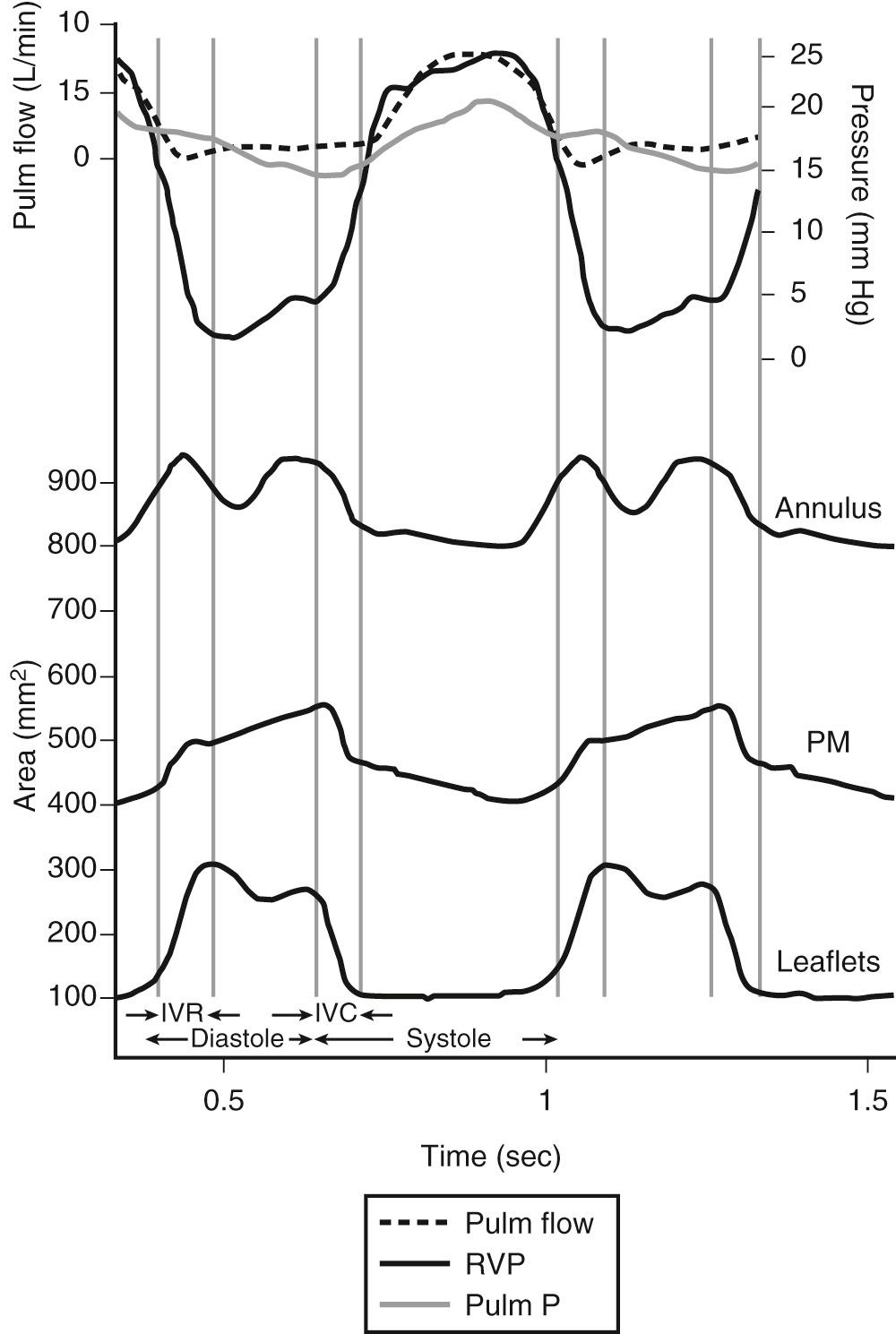
The reduction in orifice perimeter is not uniform. The segment of the annulus corresponding to the septal leaflet shortens by 12%, the anterior segment by 15%, and the posterior segment by 17%. The dilation of the annulus occurs in the anterior and posterior segments, and the dilation of the septal segment is restricted because of the relationship with the cardiac fibrous skeleton. This narrowing of the tricuspid valve orifice is due not only to contraction of its perimeter but, more important, to changes in the shape of the annulus. During contraction, the orifice becomes more elliptical because of displacement of the anteroposterior commissure toward the septum and the bulging of the septum. As in the mitral valve, the “annulus” is not in a single plane. In fact, the tricuspid valve annulus is saddle shaped, with its horn or pommel corresponding to the area of the anteroseptal commissure and its cantle to the midpoint of the base of the posterior leaflet ( Fig. 81-2 ). This saddle shape or hyperbolic paraboloid, well known to architects as an ideal design to reduce building tension, has been shown in the mitral valve to significantly reduce peak leaflet stress. Furthermore, the increase in the saddle shape during contraction has a “folding” and reducing effect on the normal tricuspid valve orifice. In cases of tricuspid regurgitation, besides an increase of tricuspid valve annulus area, there is an increase in planarity or flattening of the normal annulus, which induces leaflet tethering. Rigid structures, such as stented prostheses and rigid annuloplasty rings, destroy this configuration and are likely to have a negative impact on the function of the right ventricle.
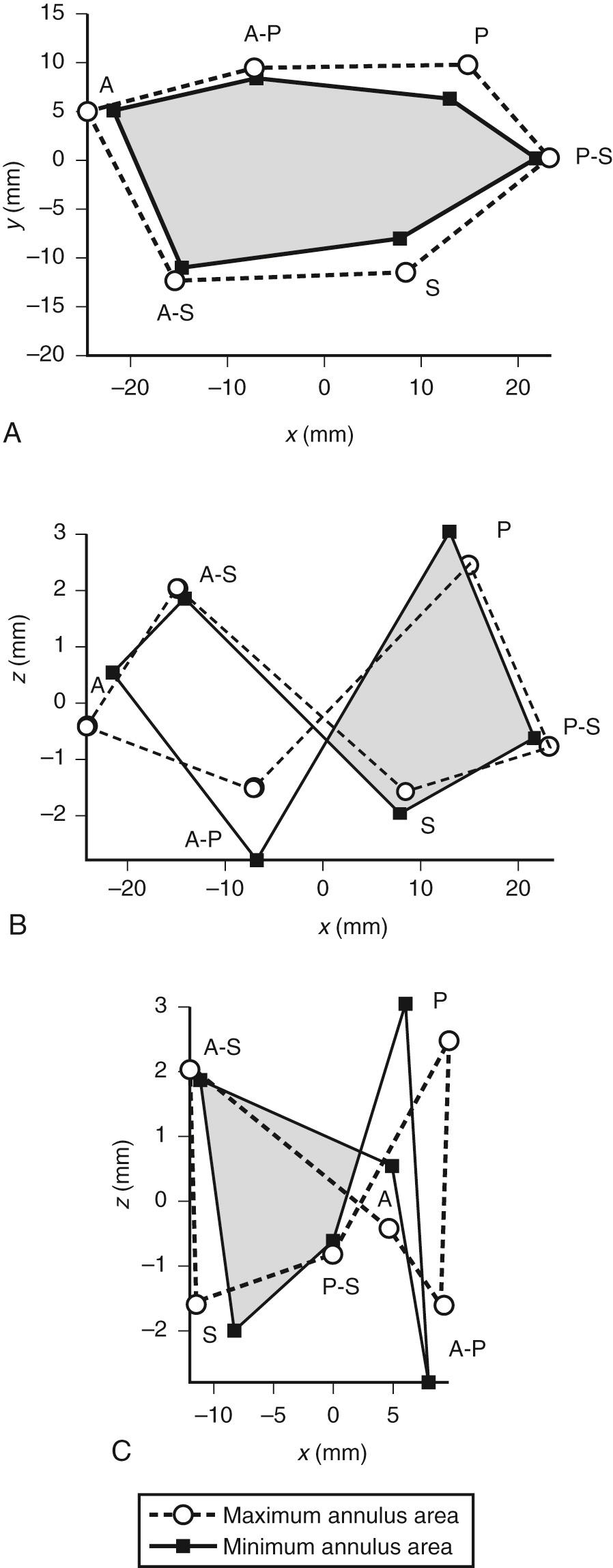
Although the number of tricuspid valve leaflets varies according to author, it is generally accepted that the tricuspid valve consists of three leaflets. These three leaflets are known as anterior, septal, and posterior, and they are separated by three clefts or commissures named anteroseptal, anteromedial, and posteroseptal ( Fig. 81-3 A ). These clefts do not reach the annulus but delineate small “commissural leaflets.” This is an important surgical point because in cases of fused commissures, their incision should not extend all the way to the annulus; doing so destroys the commissural leaflets. The largest leaflet is the anterior, followed by the posterior, with the septal being the smallest. The excursion of each leaflet (defined as the angle between leaflet free edge and the plane of the annulus) is different. The excursion of the septal leaflet is significantly smaller than that of the other leaflets. This normal, smaller septal excursion might explain the finding at surgery of a septal leaflet plastered against the septum. This finding, often seen in cases of functional regurgitation, is a sign of severity and is a predictor of a poor result after repair.
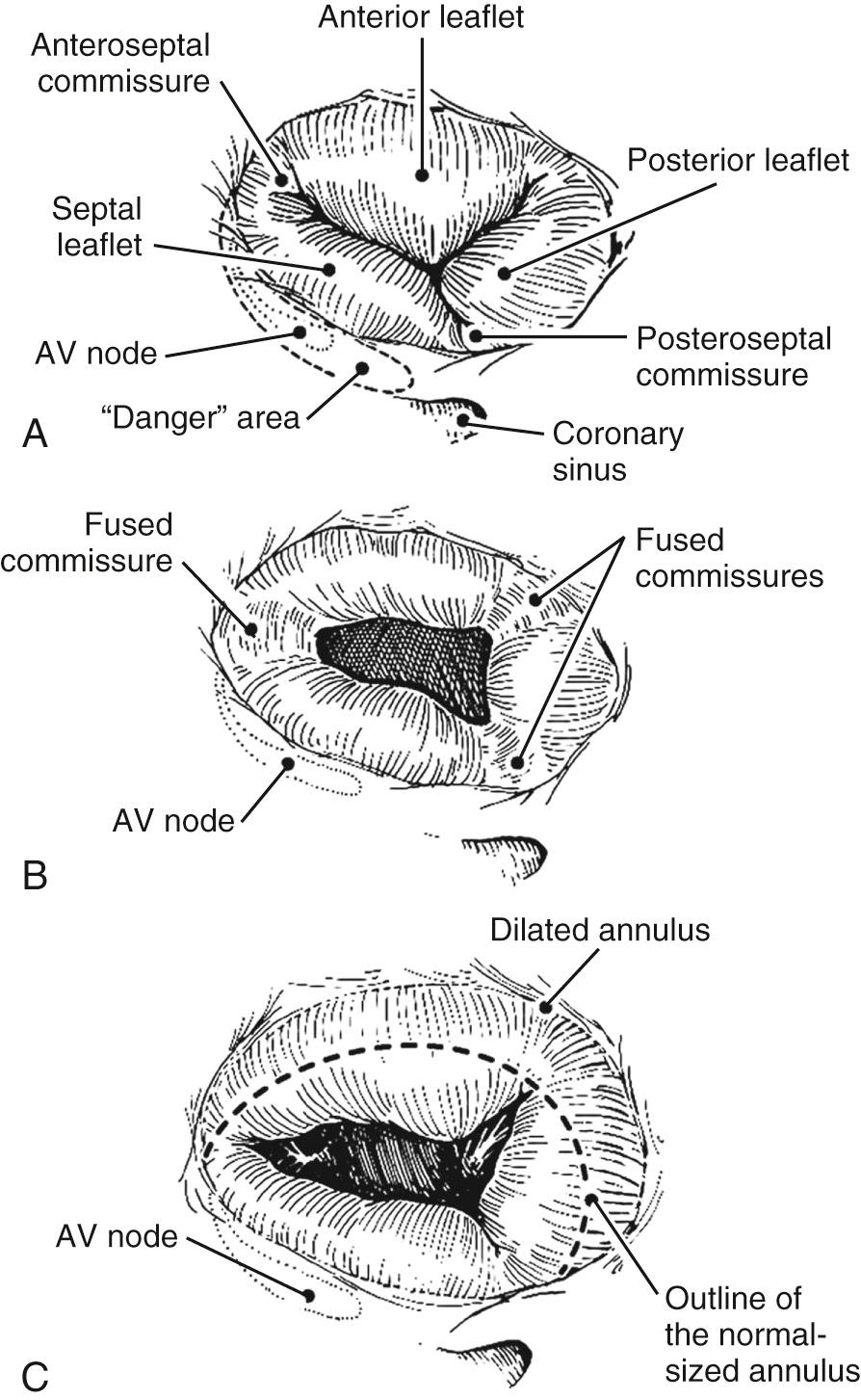
The leaflets are held down by marginal and basal chords that arise from three papillary muscle groups. The marginal chords are inserted into the leaflets free margin, and the basal chords are inserted into the ventricular surface of the leaflets. Elongation or rupture of the marginal chords results in leaflet prolapse. The basal chords of the tricuspid valve, although far less prominent than the mitral valve basal chords, probably play a similar role in maintaining valvular and ventricular geometry. In most tricuspid valve cases, three papillary muscle groups are found and can be identified as anterior, posterior, and septal. Whereas the anterior and posterior muscles are virtually always present, the septal muscle might be absent in 20% of patients. The anterior papillary muscle is the longest; it most often has a single head and sustains the largest number of chordae. Elegant anatomic studies by Victor and Nayak in hearts harvested at random confirm that every heart has a unique chordal configuration.
New surgical techniques demand deeper knowledge of the anatomy of the region and, consequently, more precise terminology. A common set of anatomic definitions is needed to report precise preoperative and postoperative echocardiographic information important to both the echocardiographer and the surgeon. Aiming to standardize all anatomic findings, Kumar and colleagues developed a detailed tricuspid valve terminology that parallels previously described mitral valve nomenclature. Although it is based on a surgical, atrial view of the valve, their terminology encompasses all three elements of the tricuspid valve apparatus (i.e., leaflets, chords, and papillary muscles).
This alphanumeric system is based on the three papillary muscle groups as defined by the numerals 1 for the anteroseptal, 2 for the posteroseptal, and 3 for the anteroposterior groups of muscles. Each leaflet is identified with the initial letter of its traditional name: S, septal; A, anterior; and P, posterior. Because the lesion does not often affect the whole leaflet or is limited to the chordae, each leaflet is divided into two areas identified by the papillary origin of the corresponding chords. For instance, the septal leaflet (S) is divided into two halves (S1 and S2), identified by the chords that originate from the anteroseptal papillary muscle or the chords that originate from the posteroseptal papillary muscle. The commissures (C) are identified by their papillary origin (1, 2, or 3) as C1, C2, and C3. All chords are identified by their papillary origin and leaflet insertion.
Although it is initially confusing, this nomenclature makes it possible to pinpoint the exact location of a lesion and to describe the surgical maneuvers applied. Its use is particularly significant for reporting of chordal disease and chordal replacement.
The area corresponding to the anteroseptal commissure is close to the aortic root noncoronary sinus of Valsalva ( Fig. 81-4 ). This fact has important surgical implications because placement of anchoring sutures for a tricuspid valve prosthetic device can be difficult at this level if a stented aortic prosthesis is already present. When a concomitant aortic valve replacement is planned, it is preferable to place the tricuspid valve sutures before undertaking the aortic valve replacement, because tears at this level can be difficult to repair. Of course, the experience and expertise of the operating surgeon finally dictates the operative procedure.
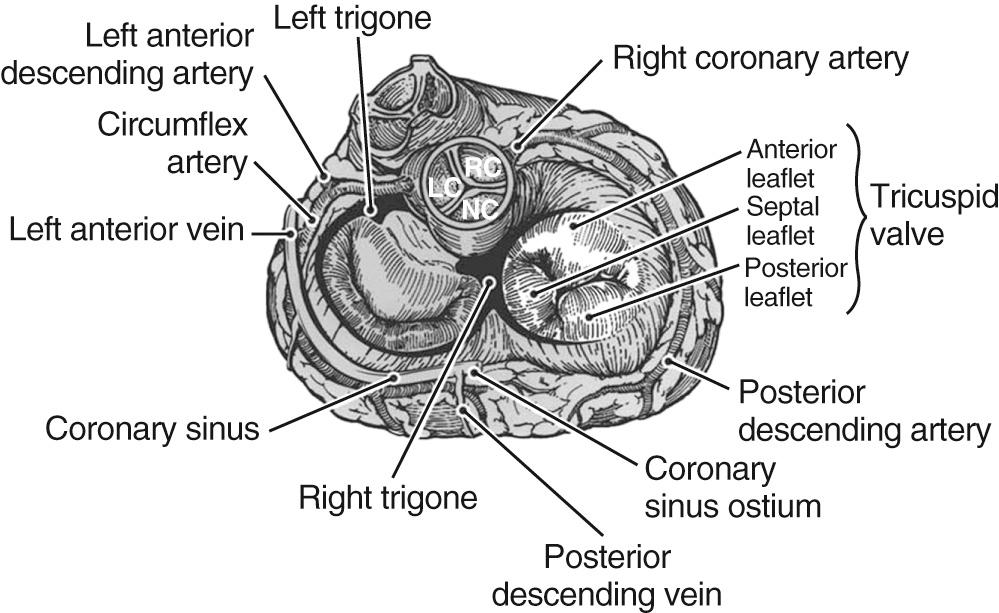
The right coronary artery and sinus run parallel to the segment of the annulus corresponding to the right ventricular free wall. Despite this proximity, injury to these vascular structures in performing a valve replacement or annuloplasty is extremely rare. The ostium of the coronary sinus is situated above the posteroseptal commissure. Because of its distance from the conducting system (close to the right trigone), it is safe to place a pursestring suture around the ostium of the coronary sinus to hold a retrograde cardioplegia cannula. This simple anchoring technique described by Martinez-Leon and colleagues more than 25 years ago allows for a reliable positioning of the retrograde cannula.
Tricuspid valve lesions have traditionally been classified into two groups: organic and functional. These classifications have an important effect on both the type of surgery performed and its long-term results. Organic lesions are those in which the valve apparatus is macroscopically abnormal (see Fig. 81-3 B ). Functional lesions are those in which regurgitation occurs in the presence of an apparently normal tricuspid valve apparatus (see Fig. 81-3 C ).
A different classification, proposed by Carpentier in relation to the pathology of the mitral valve, distinguishes three main types of disease according to the mobility of the tricuspid valve leaflets: type I, normal leaflet motion with annular dilation; type II, increased leaflet motion owing to leaflet prolapse that is secondary to chordal rupture or elongation; and type III, reduced leaflet motion due to leaflet thickening, fused commissures, or leaflet tethering.
A variety of etiologic factors can induce organic regurgitation, but still today the most frequent cause of organic tricuspid valve disease in urban populations is infective endocarditis ( Box 81-1 ). Tricuspid valve endocarditis used to be relatively rare, with an incidence of only 5% to 10% of patients with infective endocarditis; however, its frequency dramatically increased with the spread of intravenous drug abuse, with a peak incidence until early in the beginning of the twenty-first century. In this population, the tricuspid valve usually has no preexisting pathologic change. The lesions vary from isolated vegetations to total destruction of the valve, including the annulus. Staphylococcus aureus remains the most common organism found in drug addicts, followed by gram-negative organisms and Candida species. Fungal infections are also increasing because of longer periods of invasive monitoring of patients with multiorgan failure in intensive care units.
Infective endocarditis
Rheumatic fever
Degenerative (myxomatous)
Traumatic damage
Postinfarction damage
Carcinoid
Appetite-suppressant drugs
Endocardial fibroelastosis
Lupus erythematosus
Tumors (myxoma)
Mediastinal fibrosis
In the so-called developing world, rheumatic fever is the primary cause of organic valvular heart disease. Typical lesions show varying degrees of leaflet thickening and (most often) commissural fusion. In severe cases, the thickened leaflets become diaphragm-like, with a central circular orifice (see Fig. 81-3 B ). The subvalvular apparatus is seldom affected, and calcifications are rare. Although tricuspid valve stenosis is the classic lesion, predominant insufficiency is just as common. In a series of 253 patients with rheumatic heart disease who underwent tricuspid valve surgery, Prabhakar and colleagues found that organic involvement was present in 45% of the cases and that 45% of them also had annulus dilation. In a classic study of 100 postmortem hearts with rheumatic disease, Gross and Friedberg found microscopic evidence of inflammation in the annulus of all four valves (in the acute rheumatic attack). Rheumatic tricuspid valve disease is always associated with rheumatic mitral valve or mitral-aortic valve lesions. The incidence of chronic rheumatic tricuspid valve disease associated with rheumatic mitral valve disease varies widely, from 6% in an echocardiographic study to 33% in an anatomic series and 11% in the series of Prabhakar and colleagues of 1052 patients undergoing rheumatic valvular surgery. In a Mayo Clinic surgical pathology study of excised tricuspid valves at the time of valve replacement, postinflammatory etiology was responsible for 53% of the 363 valves studied. However, this frequency had diminished from 79% during the period from 1963 to 1967 to 24% during 1983 through 1987, reflecting the reduction in the incidence of rheumatic fever in the United States as it happened across Europe. Out of these regions, rheumatic heart disease is still a major epidemiologic problem. Leaflet tears and total or partial avulsion of a papillary muscle head occur after closed chest trauma. They are occasionally diagnosed at surgery and only classified postoperatively as traumatic by the patient, who recalls an old accident when prompted by the surgeon. As imaging has greatly improved in the past two decades, traumatic tricuspid regurgitation is better diagnosed and characterized.
An occasional cause of traumatic tricuspid regurgitation is that induced by the bioptome during a right myocardial biopsy in transplanted patients. Leaflet tears or chordal avulsion results in severe regurgitation that may require urgent surgery.
Degenerative tricuspid regurgitation associated with mitral valve prolapse is being increasingly observed. This double valve lesion is particularly frequent in Marfan syndrome as a manifestation of a fibrillopathy that also involves the aortic valve and ascending aorta. The reported frequency of tricuspid valve involvement among patients with mitral valve myxomatous disease ranges between 21% and 52% at all ages. Less common causes include organic tricuspid valve lesions secondary to carcinoid syndrome and appetite-suppressant drugs. In both cases, the leaflets are encased by a fibrous sheath that reduces their mobility, resulting in stenotic and regurgitant lesions. Other rare causes are listed in Box 81-1 .
Functional tricuspid insufficiency is understood to be exclusively due to annulus dilation and dysfunction (see Fig. 81-3 C ). The leaflets, chords, and papillary muscles are otherwise normal. Because of the lack of an anatomic fibrous annulus, the tricuspid valve annulus follows the dilation of the right ventricle. The total perimeter of the normal annulus is approximately 100 to 120 mm. In cases of functional tricuspid regurgitation, the circumference of the annulus can reach 150 to 170 mm. This annulus dilation is nonhomogeneous. In a postmortem study that included normal controls and hearts with rheumatic or myxomatous tricuspid valve disease, Carpentier and colleagues showed that the anterior and posterior segments of the annulus dilated far more than the septal portion of the annulus ( Fig. 81-5 ). This report, 40 years ago, formed the basis for all annuloplasties that selectively reduce the whole annulus except at the level of the septum. The role of the papillary muscles in this setting is debatable, although it can be considered a correctable influencing factor.
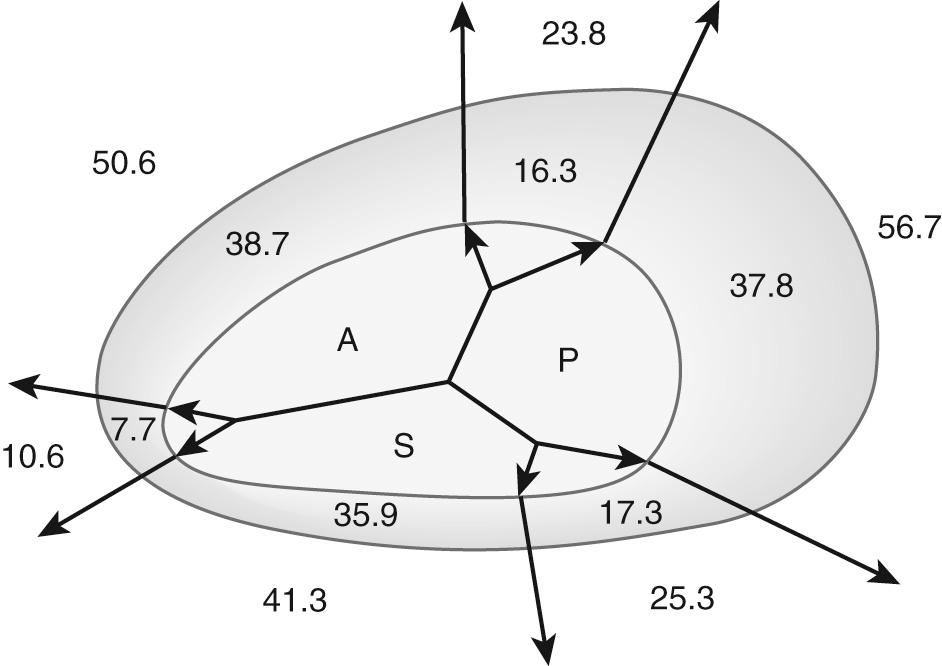
In congestive heart failure, functional tricuspid regurgitation is a predictor of poor survival and may be an independent risk factor for the development of cardiac cachexia and protein-losing enteropathy. Cardiac cachexia continues to be a major risk factor in valvular surgery of any origin. Koelling and colleagues studied a total of 1436 patients with left ventricular systolic dysfunction (ejection fraction < 35%). Mitral regurgitation was moderate in 30% and severe in 19% of patients. Moderate tricuspid regurgitation was present in 23% and severe in 12% of patients. Patients with severe mitral regurgitation were more likely also to have tricuspid regurgitation. The association is clear and it is confirmed that the severity of tricuspid regurgitation is related to the degree of congestive heart failure.
Advances in echocardiography have revealed another subvalvular mechanism that applies to both mitral and tricuspid functional regurgitations. Originally observed in functional ischemic mitral regurgitations, this mechanism also applies to the ischemic tricuspid valve and most probably to all functional insufficiencies. Right or left ventricular remodeling induces a lateral displacement of one or more papillary muscles that apically pulls through the basal chords the body of the corresponding leaflet. The leaflet becomes tethered down, losing its coaptation. Tethering in tricuspid valve regurgitation can currently be treated with valve augmentation.
Functional tricuspid regurgitation is an expression of right ventricular failure with a generalized distortion of ventricular geometry. Although annuloplasty can reduce or abolish functional tricuspid regurgitation by reducing the dilated annulus, it does not address the altered subvalvular geometry. Atrioventricular valve regurgitation is therefore influenced by extravalvular factors. Surgery addresses the myocardial component and is aimed at correcting the geometric distortion.
Right ventricular failure and subsequent functional regurgitation are to play a role in the current era of transcatheter valves. If transcatheter valves aim at reducing surgical risks in patients who are deemed inoperable or carrying a risk which is considered too high, the technology and technique should be able to offer better outcomes. In transcatheter repair of mitral regurgitation using the Mitra-Clip (Abbott Vascular, Abbott Park, IL), outcomes are influenced by the residual baseline degree of tricuspid regurgitation. This has been pointed out recently by Ohno and colleagues, confirming that 30-day primary safety endpoint was impaired in the GRASP Registry (Getting Reduction of Mitral Insufficiency by Percutaneous Clip Implantation) patients with moderate or severe residual tricuspid endocarditis. Valve regurgitation negatively influenced death and rehospitalization for congestive heart failure at 12 postoperative months; this is in contradistinction with the results after mitral valve surgery. After mitral valve repair or replacement, the risk of progression of tricuspid regurgitation is low, between 3% and 6% up to 5 years postoperatively. The rationale behind a timely operation on the mitral valve encompasses, too, a reduction in progression of tricuspid regurgitation over time.
The symptoms of the patient with tricuspid valve disease tend to be minimal and overshadowed by the more apparent left-sided symptoms. Because the tricuspid valve is situated at the entrance of the heart, its symptoms are extracardiac. With the exception of advanced cardiomyopathy, it is now uncommon to encounter a patient with the classic symptoms of venous engorgement, such as peripheral edema, hepatomegaly, and ascites. Tricuspid valve disease is mostly silent; the patient mostly complains of asthenia.
The clinical diagnosis of tricuspid valve disease has always been considered difficult. Before the advent of two-dimensional echocardiography and its application in the operating room through transesophageal probe, the surgeon used to explore the tricuspid valve digitally through the right atrium and decide whether to treat or to ignore the lesion according to the intensity of the regurgitant jet. This was a common practice three decades ago. This method has been completely abandoned because of its subjectivity and the inability to detect moderate degrees of insufficiency. Right-sided heart catheterization and ventriculography, which were considered the gold standards for the study of all cardiac valves, have been superseded by two-dimensional color Doppler echocardiography. Because of its noninvasiveness, reliability, and visual impact, two-dimensional Doppler echocardiography is the best tool for determination of the presence, degree, and etiology of tricuspid valve disease. Although transesophageal echocardiography provides invaluable anatomic information at the time of surgery, transthoracic echocardiography remains the most important examination regarding the tricuspid valve. Besides the better window obtained with transthoracic echocardiography, the main reason for its superiority lies in the notorious temporal variability in the degree of tricuspid regurgitation. This is particularly important in functional insufficiencies, in which changes in blood volume secondary to diuretic administration or vascular tone under general anesthesia can severely reduce the degree of regurgitation. Lack of awareness of these facts and exclusive reliance on intraoperative transesophageal echocardiographic examination often result in ignoring significant regurgitations. The advent of three-dimensional echocardiography is changing the perception of the estimates in tricuspid valve disease, with the understanding of the superiority of two-dimensional echocardiography.
From a surgical point of view, the essential preoperative information includes the following: whether the patient has tricuspid valve disease and whether it is organic, functional, or mixed; quantification of the degree of regurgitation and the direction of the regurgitant jet; pulmonary artery peak and mean pressures; presence and quantification of transvalvular pressure gradients; maximum and minimum tricuspid valve annulus diameter and its systolic shortening; anatomic features of the valve (i.e., leaflet thickness, mobility, billowing of the leaflet body, location of the prolapsing free edge toward the right atrium); and absence of a patent foramen ovale. It is imperative to be aware that underestimation and overestimation of the regurgitant jet area are possible because of changes in gain, filter settings, angle, and distance of the transducer. Experience is required to gain a three-dimensional concept of the direction, location, size, and number of regurgitant jets as the tricuspid annulus is a dynamic multiplanar structure with regional changes. Color Doppler study can even discover minimal regurgitations in 60% to 100% of the normal population, as documented by Yoshida and colleagues in normal subjects to set the basis for current understanding. The so-called physiologic regurgitations are useful to evaluate right ventricular and pulmonary pressures. Contrast echocardiography is a reliable method for detecting tricuspid regurgitation and a patent foramen ovale.
Semiquantitative evaluation of the severity of tricuspid regurgitation is based on the degree of penetration of the regurgitant jet into the right atrium. A jet that penetrates 2 cm into the right atrium indicates mild regurgitation. A jet that penetrates 3 to 5 cm is considered moderate regurgitation; if it is accompanied by systolic flow reversal of hepatic or caval veins, it is considered severe regurgitation. A more quantitative assessment of the degree of tricuspid regurgitation is performed by the orifice flow acceleration proximal isovelocity surface area radius method. A radius of 1 to 4 mm indicates mild regurgitation; 5 to 8 mm indicates moderate regurgitation; and greater than 9 mm indicates severe regurgitation. These methods are considered essential in the evaluation of mitral regurgitation, particularly in the intraoperative evaluation of residual regurgitations after repair, and have the same value in the tricuspid valve. Accuracy in determining the actual degree of tricuspid regurgitation is a crucial point in the surgical decision-making process.
Knowledge of the tricuspid valve annulus diameter is important for the surgeon, but its echocardiographic measurement is difficult because the annulus is not circular. As stated, it is a dynamic multiplanar structure with changing regional behavior as clearly depicted by Owais and colleagues. Small variations in the orientation of the ultrasound beam can provide radically different measurements. The search has been ongoing for a “critical annulus diameter” beyond which the tricuspid valve should not be ignored by the surgeon. Thirty years ago, Ubago and colleagues suggested 27 mm/m 2 as the “critical diameter” above which functional regurgitation always appeared ( Fig. 81-6 ). Using transthoracic echocardiographic examination of 11 consecutive patients with severe clinical tricuspid regurgitation, Come and Riley reported a nonindexed mean diastolic annulus diameter of 51 mm in the four-chamber view and 54 mm in the short-axis view. Among 15 controls, the mean annulus diameter was 34 mm in the four-chamber view and 33 mm in the short-axis view in what is almost a classical contribution. Goldman and colleagues suggested 30 mm as the cutoff point between absent or mild regurgitation and moderate to severe regurgitation.
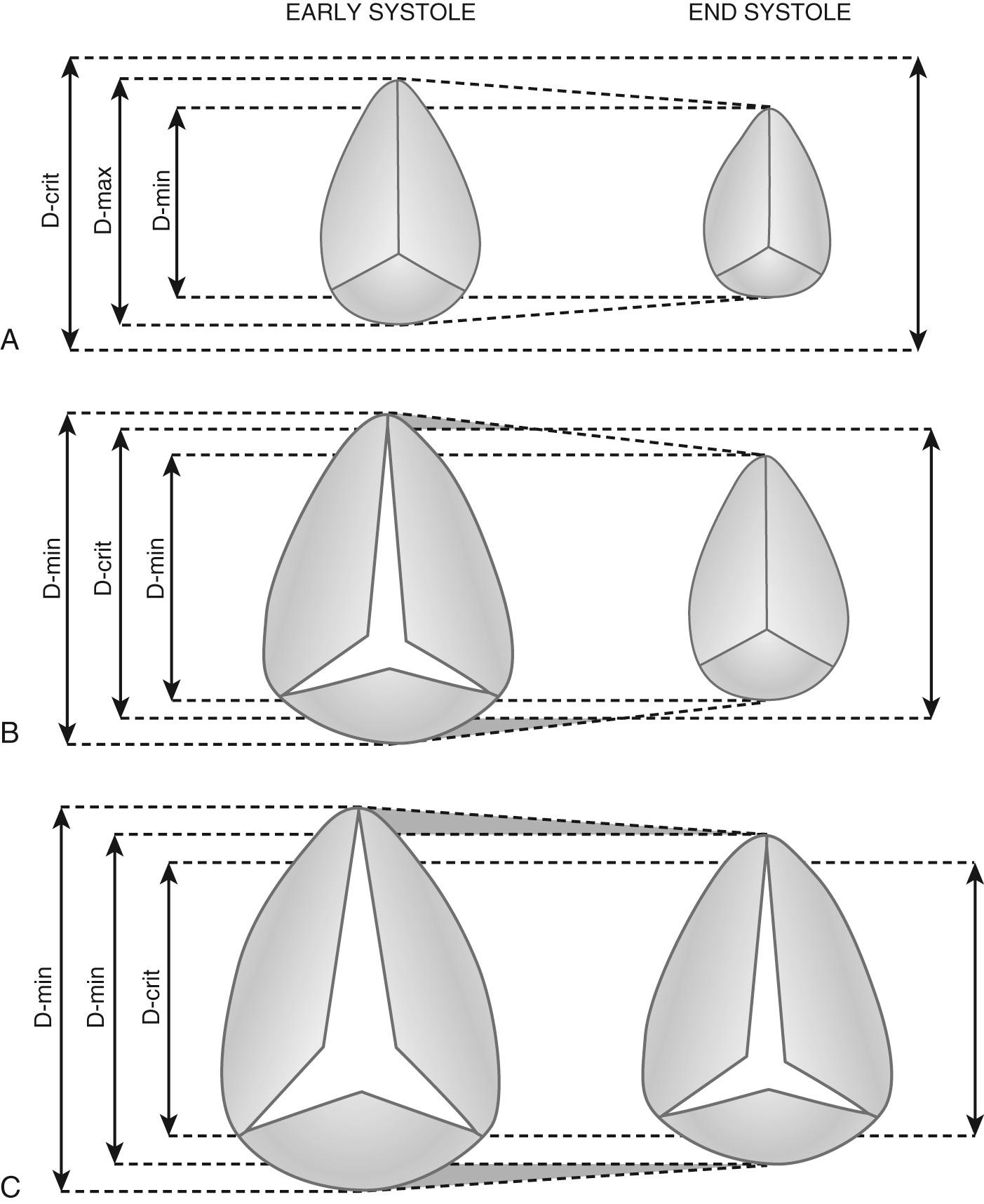
A cutoff point must be found beyond which an annuloplasty will fail. Fukuda and associates in a preoperative and postoperative echocardiographic study of 216 patients with functional tricuspid regurgitation, found that age, tethering height (distance between annulus plane and leaflet coaptation point), and severity of regurgitation were independent parameters predicting residual regurgitation. Preoperative annulus dimension was not associated with outcome of tricuspid valve annuloplasty. In practical terms, it is safe to consider a nonindexed annulus size beyond 40 mm an indication for surgery. When echocardiographic data are not available or are considered unreliable, Dreyfus and colleagues suggested using a ruler to measure the maximal stretched orifice from the anteroseptal to anteroposterior commissures. Patients with a dimension greater than or equal to 70 mm (circumference ± 140 mm, diameter ± 44 mm) should undergo annuloplasty. All of this forms the basis for the indication for annuloplasty despite some inaccuracy according to the differences among operators.
Preoperative differentiation between organic and functional tricuspid valve disease is also possible and important. Transvalvular gradients, leaflet irregularities, thickening, and doming are clear indications of organic disease. Transvalvular gradients calculated with continuous wave Doppler echocardiography have been shown to correlate well with cardiac catheterization when catheterization was widely used until echocardiography became an established and preferred diagnostic tool. The normal mean gradient is less than 2 mm Hg, and the end-diastolic gradient is nearly zero. Significant stenosis of the tricuspid valve may be present with a mean gradient of 3 to 5 mm Hg and an end-diastolic gradient of 1 to 3 mm Hg. Annulus dilation is most often present in both organic and functional lesions, but it is larger in functional regurgitation.
Three-dimensional echocardiography, although preferred for the assessment of the mitral valve, has expanded knowledge of the geometric changes in the normal and diseased tricuspid valve. It is already providing invaluable information on the annulopapillary complex in any valve condition. Accurate assessment is required.
The current consensus is that most diseased tricuspid valves can be repaired easily. Severe lesions are usually treated, but real or erroneously labeled “moderate” lesions are ignored. The problem in the past used to be often related to the absence of a detailed preoperative search for tricuspid valve disease. Intraoperative decision making is unreliable unless the lesion is severe. Preoperative transthoracic echocardiography specifically interrogating the tricuspid valve is an absolute requirement. Current trends in three-dimensional echocardiography result in additional preoperative information per the changing behavior of the tricuspid annulus, which is useful in surgical planning. The value of intraoperative transesophageal echocardiography cannot be neglected.
In the early phases of valve surgery, the current knowledge indicated that tricuspid regurgitation in the setting of stenotic valve disease could be solved after mitral valve replacement. This conservative approach was based on the assumption of postoperative regression of pulmonary hypertension, which would reduce the tricuspid regurgitation. However, early reports like that of Duran and colleagues stressed the effect of residual tricuspid regurgitation on outcomes and warned on the need for early repair of mitral lesions and tricuspid organic disease, when analyzing 150 patients with mitral valve repair and concomitant tricuspid valve disease. Almost 40 years later, there is agreement that residual noncorrected tricuspid regurgitation is associated with suboptimal or poor outcomes. These patients with residual uncorrected regurgitation remain at high risk of cardiac death over the follow-up. Reoperative tricuspid patients requiring valve replacement are clinically in poor condition and increased pulmonary hypertension.
The severity of the lesion and its reparability are major drivers for the indication for surgery. As stated, the preoperative clinical condition plays a role in the outcomes, too. Severe lesions demand surgical correction regardless of whether repair or replacement will be performed. Moderate lesions should be treated if repair is expected. This principle emphasizes the importance of a precise and accurate preoperative diagnosis. The advances in imaging have allowed better understanding of tricuspid disease and better surgical planning.
Become a Clinical Tree membership for Full access and enjoy Unlimited articles
If you are a member. Log in here